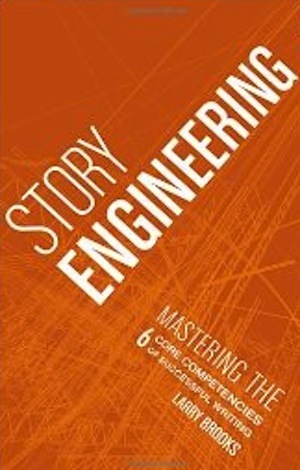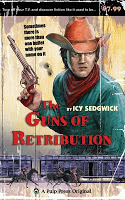Story Structure - Pulp
 If you follow me on Twitter, among the copious tweets about who I would hire to provide the voice for my supervillain car (John Hurt and Mark Strong are the front-runners thus far but I'm sure I could accommodate Nathan Fillion) or my constant pleas to Hollywood to just GIVE THE SHAKY CAM A BLOODY REST, then you might have noticed a recent "wobble" in my normally impeccable self confidence [sic].
If you follow me on Twitter, among the copious tweets about who I would hire to provide the voice for my supervillain car (John Hurt and Mark Strong are the front-runners thus far but I'm sure I could accommodate Nathan Fillion) or my constant pleas to Hollywood to just GIVE THE SHAKY CAM A BLOODY REST, then you might have noticed a recent "wobble" in my normally impeccable self confidence [sic].I realised that if I'm not posting writing prompts or Friday flash stories, then the rest of my blog posts are either book reviews or "writing advice". Now, I'll be honest with you. I do suffer from crippling self-esteem problems. I do get rattled by negative reviews. I do tie myself up in knots over whether or not people will be entertained by what I've written. So when I tried to think about what to dispense in the way of writing advice, I suddenly thought "Hang on, who the hell are you to tell people how to write?" It really bothered me. I mean, it's not like I'm Stephen King, is it? Still, as various valued tweeters pointed out, I have put out two books on my own that received good reviews, and I had my beloved Guns of Retribution published by the ever-awesome Pulp Press, so while I may not be anyone special, perhaps I can share something I've learned along the way.
 One of the things I have learned is that story structure is probably the single most important thing that you can master. Dialogue, character, theme - these are all vital to the success of your story, but without a strong structure in which to place them, it's all just dust in the wind, dude. Normally I would cite Larry Brooks' Story Engineering or James Scott Bell's Plot & Structure at this point - they're both excellent books and I highly recommend them both for really getting your head around why successful stories work, and how you can give your own stories a fighting chance. Yes, there is a reason that books that may seem to be badly-written, predictable or full of crap characters still succeed, and it all comes down to how the story unfolds.
One of the things I have learned is that story structure is probably the single most important thing that you can master. Dialogue, character, theme - these are all vital to the success of your story, but without a strong structure in which to place them, it's all just dust in the wind, dude. Normally I would cite Larry Brooks' Story Engineering or James Scott Bell's Plot & Structure at this point - they're both excellent books and I highly recommend them both for really getting your head around why successful stories work, and how you can give your own stories a fighting chance. Yes, there is a reason that books that may seem to be badly-written, predictable or full of crap characters still succeed, and it all comes down to how the story unfolds.The reason I said "normally" is because there are other ways. Bell reduces structure to three acts; the first act sets up the plot, introducing us to the protagonist, and establishing their world. Act two begins when some sort of defining incident occurs, pushing the protagonist forward. Bell describes this point as being a doorway of no return - something happens to prevent the protagonist from returning to their previous way of life. Act two is the main bulk of the action, but there's still the possibility they could walk away. Finally, we reach another propelling incident pushes them into act three, an incident which forces them to put into action any plans they've made, or do whatever it is they have to do. It's a solid structure, and it works. Brooks breaks it down even further into hooks, plot points, midpoints, and Lord knows what else - I won't sport with your intelligence by breaking it down further, but the book really does explain a lot.
But there is another way. In 1904, Lester Dent was born in Missouri. In 1929, he sold his first story to Top Notch magazine. He became a hugely successful pulp author throughout the 1930s and 40s, writing all but twenty of the 181 Doc Savage novels about an adventure character who attained near-superhero status. Dent's Master Fiction Plot, also known as the Lester Dent Formula, is often given as an alternative plot for pulp stories of around 6000 stories. In it, Dent splits the plot into four, not the traditional three.
In the first quarter, we are introduced to the hero, along with his mystery (or whatever suits the genre). He has an initial attempt at sorting things out - and fails. Somewhere near the end of the first quarter, he ends up in trouble (usually physical conflict) and there is a twist in the plot. In the second quarter, more grief is heaped onto the hero - he struggles on, leading to another conflict, and another plot twist. The third quarter sees more grief for the hero, although he manages to make some kind of headway before he ends up in yet more conflict, and has to cope with another twist. The final quarter sees the hero really neck deep in the brown stuff, although he manages to free himself either through skill or strength. He heads off to solve the mystery and navigate the final plot twist.
 Naturally that all seems a little formulaic but hey, he was writing pulp fiction. If you're interested, check the actual article out. The Master Plot is supposed to apply to 6000 word stories, but I used it when I wrote One Woman Cure for the forthcoming For Books' Sake anthology, Short Stack, and I even applied it (albeit loosely) to The Guns of Retribution. Why? Well, as much as The Guns of Retribution might be a Western, it is also a pulp Western, and as such subscribes to the conventions of the pulp genre (e.g. the femme fatale). I won't be using the pulp plot for the as-yet-unnamed sequel, but that's because I'm going down a supernatural route with this one, and I think that demands a more traditional structure. But I want to write more pulp in future, so I won't rule out using it again.
Naturally that all seems a little formulaic but hey, he was writing pulp fiction. If you're interested, check the actual article out. The Master Plot is supposed to apply to 6000 word stories, but I used it when I wrote One Woman Cure for the forthcoming For Books' Sake anthology, Short Stack, and I even applied it (albeit loosely) to The Guns of Retribution. Why? Well, as much as The Guns of Retribution might be a Western, it is also a pulp Western, and as such subscribes to the conventions of the pulp genre (e.g. the femme fatale). I won't be using the pulp plot for the as-yet-unnamed sequel, but that's because I'm going down a supernatural route with this one, and I think that demands a more traditional structure. But I want to write more pulp in future, so I won't rule out using it again.All I'm trying to say is that structure is important, but it's also something to be explored. Whether you use three acts, three acts and a crapload of points in between, or quartiles, find a structure that works for your story and stick to it. Your readers will thank you.

Published on November 15, 2011 14:51
No comments have been added yet.



